Kamagorgon
| Kamagorgon Temporal range: Permian, 270.6–260.4Ma | |
|---|---|
 | |
| Life restoration of Kamagorgon ulanovi | |
| Scientific classification | |
| Kingdom: | Animalia |
| Phylum: | Chordata |
| Clade: | Synapsida |
| Order: | Therapsida |
| Clade: | Theriodontia |
| Suborder: | †Gorgonopsia (?) |
| Genus: | †Kamagorgon Tatarinov, 1998 |
| Type species | |
| †Kamagorgon ulanovi Tatarinov, 1998 | |
Kamagorgon is an extinct genus of therapsid from the Middle Permian of Russia. The type and only species is Kamagorgon ulanovi. It is only known from an incomplete skull. The snout is short and the canine teeth are very large. Kamagorgon was named in 1998 and originally classified in the biarmosuchian family Eotitanosuchidae along with the poorly known therapsid Eotitanosuchus.[1] More recently, Kamagorgon has considered as a primitive gorgonopsian rather than a biarmosuchian.[2]
References
- ↑ Tatarinov, L.P. (1998). "A new eotitanosuchid (Reptilia, Therapsida) from the Kazanian Stage (Upper Permian) of Udmurtia". Paleontological Journal 33 (6): 660–666.
- ↑ Kemp, T. S. (2006). "The origin and early radiation of the therapsid mammal-like reptiles: A palaeobiological hypothesis". Journal of Evolutionary Biology 19 (4): 1231–1247. doi:10.1111/j.1420-9101.2005.01076.x. PMID 16780524.
| |||||||||||||||||||||||||||||||
